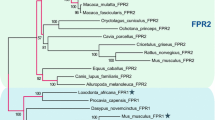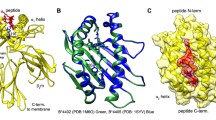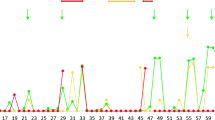Abstract
The leading model for class I-b evolution suggests non-polymorphic I-b genes evolve by gene duplication from polymorphic I-a genes. We recently found N-formyl peptide-specific orthologs of the class I-b gene H2-M3 in the rodent subfamily Sigmodontinae. To test if sigmodont M3 is a I-b gene, we sequenced M3 from wild cotton rats (Sigmodon hispidus) diverse at the class II locus, Sihi-DQA. These haplotypes carry a single allele of M3 that closely resembles H2-M3. However, peptide-binding assays showed that cotton rat M3 bound the chemotactic N-formylpeptide fMLF better than did rat or mouse M3. The Ala116→Lys substitution in cotton rat M3 might enhance binding of fMLF and is one of eight residues of M3 that interact with ligand residues P3 and P4 and that are positively selected, with a d N /d S ratio of 1.8. Thus, M3 is a class I-b gene in both sigmodontine and murine murids, but positive selection operates on a small subset of residues in the traditionally defined antigen recognition site.




Similar content being viewed by others
References
Alvarez M, Martinez-Laso J, Varela P, Diaz-Campos N, Gomez-Casado E, Vargas-Alarcon G, Garcia-Torre C, Arnaiz-Villena A (1997) High polymorphism of Mhc-E locus in non-human primates: alleles with identical exon 2 and 3 are found in two different species. Tissue Antigens 49:160–167
Arnason U, Gullberg A, Janke A, Xu X (1996) Pattern and timing of evolutionary divergences among hominoids based on analyses of complete mtDNAs. J Mol Evol 43:650–661
Bainbridge DR, Ellis SA, Sargent IL (1999) Little evidence of HLA-G mRNA polymorphism in Caucasian or Afro-Caribbean populations. J Immunol 163:2023–2027
Barlow DJ, Thornton JM (1983) Ion-pairs in proteins. J Mol Biol 168:867–885
Bjorkman PJ, Saper MA, Samraoui B, Bennett WS, Strominger JL, Wiley DC (1987) The foreign antigen binding site and T cell recognition regions of class I histocompatibility antigens. Nature 329:512–518
Boyson JE, Iwanaga KK, Urvater JA, Hughes AL, Golos TG, Watkins DI (1999) Evolution of a new nonclassical MHC class I locus in two Old World primate species. Immunogenetics 49:86–98
Chiu NM, Wang B, Kerksiek KM, Kurlander R, Pamer EG, Wang CR (1999) The selection of M3-restricted T cells is dependent on M3 expression and presentation of N-formylated peptides in the thymus. J Exp Med 190:1869–1878
Crew MD, Bates LM (2003) Sequence, expression, and polymorphism of the Peromyscus leucopus Mhc class Ib gene, M4. Immunogenetics 55:95–99
Doyle CK, Davis BK, Cook RG, Rich RR, Rodgers JR (2003) Hyperconservation of the N-formyl peptide binding site of M3: evidence that M3 is an old eutherian molecule with conserved recognition of a pathogen-associated molecular pattern. J Immunol 171:836–844
Elsner HA, Schroeder M, Blasczyk R. (2001) The nucleotide diversity of MICA and MICB suggests the effect of overdominant selection. Tissue Antigens 58:419–421
Hughes AL, Nei M (1989) Evolution of the major histocompatibility complex: independent origin of nonclassical class I genes in different groups of mammals. Mol Biol Evol 6:559–579
Hughes AL, Nei M (1988) Pattern of nucleotide substitution at major histocompatibility complex class I loci reveals overdominant selection. Nature 335:167–170
Hughes AL, Yeager M, Ten Elshof AE. and Chorney MJ (1999) A new taxonomy of mammalian MHC class I molecules. Immunol Today 20:22–26
Klein J, Figueroa F (1986) Evolution of the major histocompatibility complex. Crit Rev Immunol 6:295–386
Korber B (2001) HIV signature and sequence variation analysis. Computational analysis of HIV molecular sequences. In: Rodrigo AG, Learn GH (eds)Computational analysis of HIV molecular sequences. Kluwer, Dordrecht
Kumar S, Hedges SB (1998) A molecular timescale for vertebrate evolution. Nature 392:917–920
Kumar S, Nussinov R (2002) Close-range electrostatic interactions in proteins. Chembiochem 3:604–617
Kumar S, Tamura K, Jakobsen IB, Nei M (2001) MEGA2: molecular evolutionary genetics analysis software. Bioinformatics 17:1244–1245
Langley RJ, Prince GA, Ginsberg HS (1998) HIV type-1 infection of the cotton rat (Sigmodon fulviventer and S. hispidus). Proc Natl Acad Sci USA 95:14355–14360
Lenz LL, Bevan MJ (1996) H2-M3 restricted presentation of Listeria monocytogenes antigens. Immunol Rev 151:107–121
Lenz LL, Dere B, Bevan MJ (1996) Identification of an H2-M3-restricted Listeria epitope: implications for antigen presentation by M3. Immunity 5:63–72
Loveland B, Wang C-R, Yonekawa H, Hermel E, Fischer Lindahl K (1990) Maternally transmitted histocompatibility antigen of mice: a hydrophobic peptide of a mitochondrially encoded protein. Cell 60:971–980
Lynch M, O'Hely M, Walsh B, Force A (2001) The probability of preservation of a newly arisen gene duplicate. Genetics 159:1789–1804
McDonald JH, Kreitman M (1991) Adaptive protein evolution at the Adh locus in Drosophila. Nature 351:652–654
Michaux J, Reyes A, Catzeflis F (2001) Evolutionary history of the most speciose mammals: molecular phylogeny of muroid rodents. Mol Biol Evol 18:2017–2031
Nei M, Gojobori T (1986) Simple methods for estimating the numbers of synonymous and nonsynonymous nucleotide substitutions. Mol Biol Evol 3:418–426
Niewiesk S, Gotzelmann M, ter Meulen V (2000) Selective in vivo suppression of T lymphocyte responses in experimental measles virus infection. Proc Natl Acad Sci USA 97:4251–4255
Otting N, Bontrop RE (1993) Characterization of the rhesus macaque (Macaca mulatta) equivalent of HLA-F. Immunogenetics 38:141–145
Ozato K, Hansen TH, Sachs DH (1980) Monoclonal antibodies to mouse MHC antigens II. Antibodies to the H-2 Ld antigen, the products of a third polymorphic locus of the mouse major histocompatibility complex. J Immunol 125:2473–2477
Pérez-Rodriguez M, Argüello JR, Fischer G, Corell A, Cox ST, Robinson J, Hossain E, McWhinnie A, Travers PJ, Marsh SG, Madrigal JA (2002) Further polymorphism of the MICA gene. Eur J Immunogenet 29:35–46
Pfau RS, Van Den Bussche RA, McBee K, Lochmiller RL (1999) Allelic diversity at the Mhc-DQA locus in cotton rats (Sigmodon hispidus) and a comparison of DQA sequences within the family Muridae (Mammalia: Rodentia). Immunogenetics 49:886–893
Pfau RS, McBee K, Van Den Bussche RA (2001a) Genetic diversity of the major histocompatibility complex of cotton rats (Sigmodon hispidus) inhabiting an oil refinery complex. Environ Toxicol Chem 20:2224–2228
Pfau RS, Van Den Bussche RA, McBee K (2001b) Population genetics of the hispid cotton rat (Sigmodon hispidus): patterns of genetic diversity at the major histocompatibility complex. Mol Ecol 10:1939–1945
Pullen JK, Hunt HD, Horton RM, Pease LR (1989) The functional significance of two amino acid polymorphisms in the antigen-presenting domain of class I MHC molecules. J Immunol 143:1674–1679
Ronchese F, Brown MA, Germain RN (1987) Structure-function analysis of the Abm12β mutation using site-directed mutagenesis and DNA-mediated gene transfer. J Immunol 139:629–638
Shawar SM, Cook RG, Rodgers JR, Rich RR (1990) Specialized functions of MHC class I molecules I. An N-formyl peptide receptor is required for construction of the class I antigen Mta. J Exp Med 171:897–912
Toomajian C, Kreitman M (2002) Sequence variation and haplotype structure at the human HFE locus. Genetics 161:1609–1623
Urvater JA, Otting N, Loehrke JH, Rudersdorf R, Slukvin II, Piekarczyk MS, Golos TG, Hughes AL, Bontrop RE, Watkins DI (2000) Mamu-I: a novel primate MHC class I B-related locus with unusually low variability. J Immunol 164:1386–1398
Vyas JM, Rich RR, Howell DD, Shawar SM, Rodgers JR (1994) Availability of endogenous peptides limits expression of an M3a-Ld major histocompatibility complex class I chimera. J Exp Med 179:155–165
Vyas JM, Rodgers JR, Rich RR (1995) H-2M3a violates the paradigm for MHC class I peptide binding. J Exp Med 181:1817–1825
Wang CR, Fischer Lindahl K (1993) HMT, encoded by H-2M3, is a neoclassical major histocompatibility class I antigen. Proc Natl Acad Sci USA 90:2784–2788
Wang CR, Castano AR, Peterson PA, Slaughter C, Lindahl KF, Deisenhofer J (1995) Nonclassical binding of formylated peptide in crystal structure of the MHC class Ib molecule H2-M3. Cell 82:655–664
Watkins DI, Chen ZW, Hughes AL, Evans MG, Tedder TF, Letvin NL (1990) Evolution of the MHC class I genes of a New World primate from ancestral homologues of human non-classical genes. Nature 346:60–63
Yang Z (2002) Inference of selection from multiple species alignments. Curr Opin Genet Dev 12:688–694
Acknowledgements
We thank K. McBee and R. Pfau for discussions and curated S. hispidus DNA and our anonymous reviewers for constructive critiques. This work was supported by NIH RO1 AI30036 to R.R.R. and R.G.C., AI18882 to R.R.R. and J.R.R., and RO1 AI17897 to R.G.C. and J.R.R.
Author information
Authors and Affiliations
Corresponding author
Electronic Supplementary Material
Rights and permissions
About this article
Cite this article
Doyle, C.K., Cook, R.G., Rich, R.R. et al. Cotton rat Sihi-M3 is a minimally oligomorphic Mhc I-b molecule that binds the chemotactic peptide fMLF under stringent conditions. Immunogenetics 55, 389–394 (2003). https://doi.org/10.1007/s00251-003-0593-6
Received:
Revised:
Published:
Issue Date:
DOI: https://doi.org/10.1007/s00251-003-0593-6






